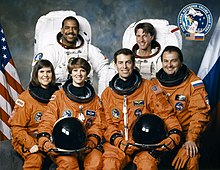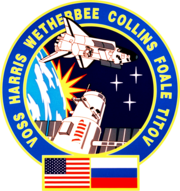STS-63

Discovery launches on STS-63
|
|
| Mission type | Research Mir rendezvous |
|---|---|
| Operator | NASA |
| COSPAR ID | 1995-004A |
| SATCAT № | 23469 |
| Mission duration | 8 days, 6 hours, 28 minutes, 15 seconds |
| Distance travelled | 4,816,454 kilometers (2,992,806 mi) |
| Orbits completed | 129 |
| Spacecraft properties | |
| Spacecraft | Space Shuttle Discovery |
| Payload mass | 8,641 kilograms (19,050 lb) |
| Crew | |
| Crew size | 6 |
| Members |
James D. Wetherbee Eileen Collins Bernard A. Harris, Jr. Michael Foale Janice E. Voss Vladimir G. Titov |
| Start of mission | |
| Launch date | 3 February 1995, 05:22:04 UTC |
| Launch site | Kennedy LC-39B |
| End of mission | |
| Landing date | 11 February 1995, 11:50:19 UTC |
| Landing site | Kennedy SLF Runway 15 |
| Orbital parameters | |
| Reference system | Geocentric |
| Regime | Low Earth |
| Perigee | 275 kilometres (171 mi) |
| Apogee | 342 kilometres (213 mi) |
| Inclination | 51.6 degrees |
| Period | 92.3 minutes |
 Left to right - Seated: Voss, Collins, Wetherbee, Titov; Standing: Harris, Foale |
|
STS-63 was the first mission of the US/Russian Shuttle-Mir Program, which carried out the first rendezvous of the American Space Shuttle with Russia's space station Mir. Known as the 'Near-Mir' mission, the flight used Space Shuttle Discovery, which lifted off from launch pad 39B on 3 February 1995 from Kennedy Space Center, Florida. A night launch and the 20th mission for Discovery, it marked the first time a Space Shuttle mission had a female pilot, Eileen Collins, the first EVAs for both a UK born astronaut Michael Foale and a US astronaut of African heritage Bernard A. Harris, Jr. and it also carried out the successful deployment and retrieval of the Spartan-204 platform, along with the scheduled rendezvous and flyaround of Mir, in preparation for STS-71, the first mission to dock with Mir.
STS-63's primary objective was to perform a rendezvous and fly around the Russian space station Mir. The objectives of the Mir Rendezvous/Flyby were to verify flight techniques, communications and navigation aid sensor interfaces, and engineering analyses associated with Shuttle/Mir proximity operations in preparation for the STS-71 docking mission.
Other objectives of the flight were to perform the operations necessary to fulfill the requirements of experiments located in SPACEHAB-3 and to fly captively, then deploy and retrieve the Spartan-204 payload. Spartan-204, the Shuttle Pointed Autonomous Research Tool for Astronomy, was a free-flying retrievable platform. It was designed to obtain data in the far ultraviolet region of the spectrum from diffuse sources of light. Two crewmembers were scheduled to perform a five-hour spacewalk.
...
Wikipedia

